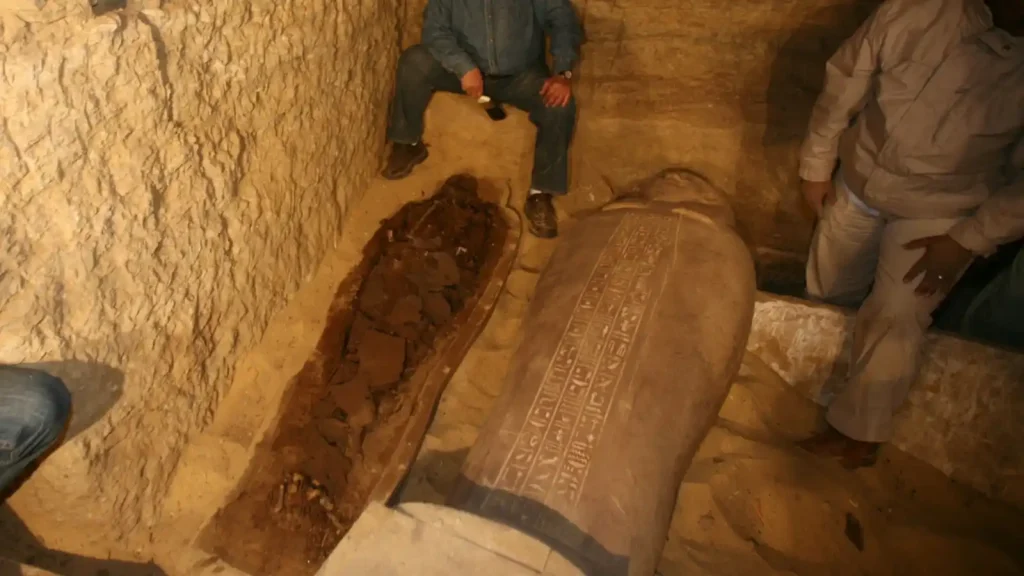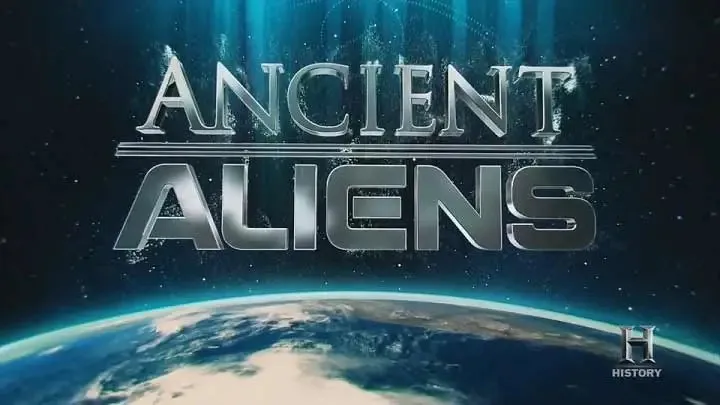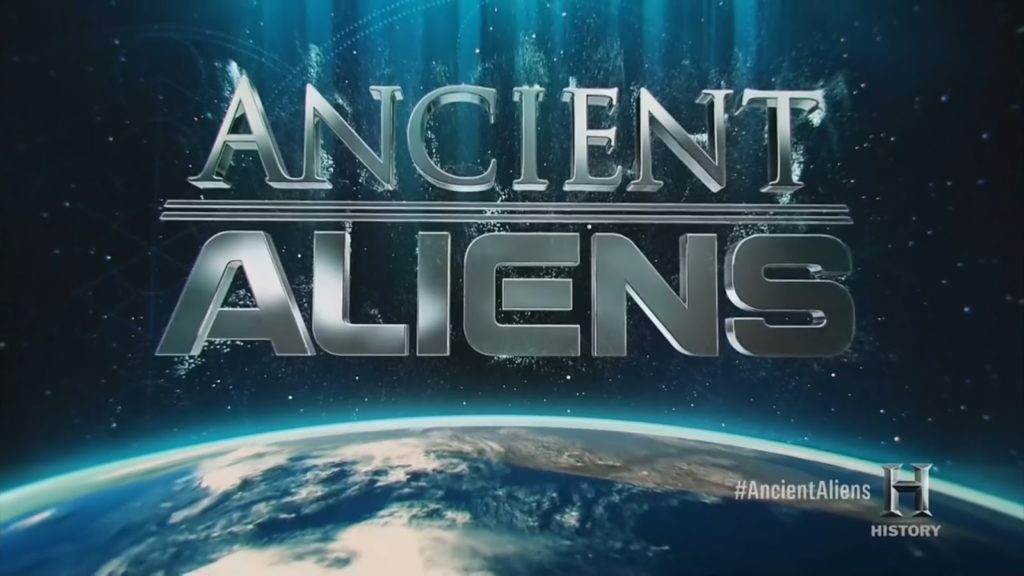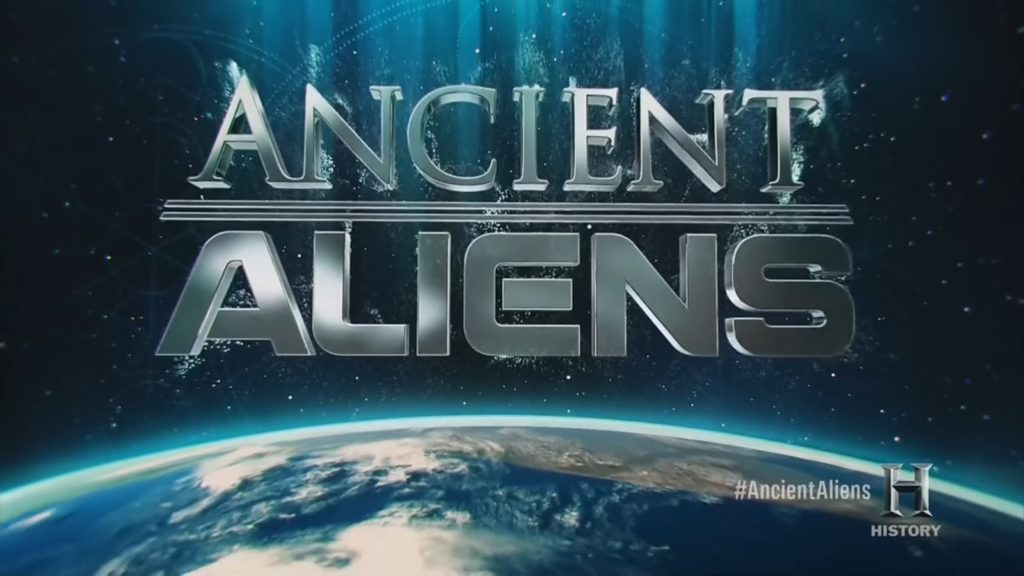Ancient Aliens – S20E17 | Egypt’s Giant Tombs: Beneath the vast, arid deserts of Egypt, a fascinating discovery unveils the mystery of 24 colossal sarcophagi, each found astonishingly vacant. These monumental stone caskets, each carved from a single block of stone and weighing over 70 tons, challenge the conventional boundaries of ancient Egyptian craftsmanship and ingenuity.
This episode delves into the enigmatic purpose and origins of these giant tombs, raising profound questions about the capabilities and technologies of ancient civilizations. How were the ancient Egyptians able to quarry, carve, and transport these immense stone boxes across great distances without the machinery available today? What advanced techniques were employed to achieve such precision in their craftsmanship?
The sheer scale and precision of these sarcophagi suggest a level of technological sophistication that some believe could not have been possible without some form of advanced knowledge or assistance. This has led to intriguing theories about the involvement of extraterrestrial influences. Could these giant tombs have been designed by alien visitors? The episode explores various theories that propose these stone boxes were used not merely for burial purposes but perhaps had a more arcane significance linked to ancient Egyptian cosmology and celestial alignment.
Adding to the mystery is the fact that these sarcophagi are empty. There are no remains of any bodies, no inscriptions, and seemingly no clues that point towards their intended use. This absence of any human remains or artifacts within these sarcophagi fuels speculation about their true purpose. Were these giant stone boxes intended for some ritualistic or ceremonial use that required such grandeur and precision? Or is there an even more profound significance to their emptiness?
Experts in Egyptology, archaeology, and engineering weigh in, providing insights based on the latest research and archaeological findings. They discuss the historical context of these sarcophagi, comparing them to other similar finds and examining the symbolic and functional aspects of sarcophagi in ancient Egyptian culture.
Ancient Aliens – S20E17 | Egypt’s Giant Tombs
The episode also incorporates stunning visual recreations of what these tombs might have looked like in their original glory, along with computer-generated imagery that illustrates potential methods of construction and transportation used by the ancient Egyptians. These visual aids help viewers imagine the scale of effort and engineering prowess required to create such monumental artifacts.
As the investigation unfolds, the narrative also considers the broader implications of these findings on our understanding of ancient civilizations. If indeed these sarcophagi were the work of extraterrestrial visitors, as some theorists suggest, what does that imply about human history and the development of early civilizations on Earth? Alternatively, if these were purely human achievements, how might this change our perception of human ingenuity and technological advancement in ancient times?
“Ancient Aliens” invites viewers to ponder these questions, leaving them with a sense of wonder and curiosity about the ancient world. The episode serves not only as a deep dive into one of Egypt’s great archaeological mysteries but also as a platform for broader discussion about the origins and capabilities of ancient civilizations, challenging the audience to think beyond traditional historical narratives.
By the conclusion of the episode, the mystery of Egypt’s giant tombs remains as enigmatic as ever. With each hypothesis and explanation presented, more questions arise, fueling ongoing research and debate among scholars and enthusiasts alike. This exploration into the depths of Egypt’s ancient past reveals not just the limits of our current understanding but also the endless possibilities that lie in reevaluating what we think we know about the ancient world.
Egypt’s Giant Tombs

The Enigma of Egypt’s Serapium
Beneath the shifting sands of Egypt, a mystery sleeps—a riddle carved in stone that has baffled historians and archaeologists for over a century. The Serapium of Saqqara, an ancient subterranean complex, stands as a silent witness to a forgotten era, guarding secrets that challenge our understanding of ancient civilizations. Among these secrets are 24 massive stone sarcophagi, each one a marvel of engineering and craftsmanship. Yet, despite their grandeur, these sarcophagi remain empty, their purpose obscured by the passage of millennia.
The Serapium isn’t just a relic of the past; it’s a beacon that calls us to question everything we know about history. How did the ancient Egyptians, with their seemingly primitive tools, carve these colossal boxes with such precision? What drove them to bury these enormous sarcophagi deep beneath the earth, in a chamber so meticulously constructed? The answers, it seems, are locked within the stone itself, waiting for someone to decipher their meaning.
Discovery of the Colossal Stone Sarcophagi
In 1850, French archaeologist Auguste Mariette stumbled upon the Serapium during his search for ancient manuscripts. What he uncovered was beyond anything he could have imagined. Hidden beneath the sands of Saqqara, the Serapium revealed its secrets slowly, like a desert mirage coming into focus. As Mariette’s team cleared the ancient tunnels, they unearthed the first of the giant stone sarcophagi. These weren’t just burial boxes—they were monumental achievements, each weighing more than 70 tons and carved with a precision that defies explanation.
Mariette’s discovery sent shockwaves through the archaeological community. The sheer size of the sarcophagi was astonishing, but even more perplexing was their emptiness. Who, or what, were these enormous stone boxes meant to hold? And why were they left abandoned, without a trace of their intended occupants? These questions have haunted scholars ever since, leading to endless speculation and debate.
Unraveling Ancient Mysteries: Purpose and Design of the Serapium
The purpose of the Serapium and its giant sarcophagi remains one of the great unsolved mysteries of Egyptology. Some believe that the sarcophagi were meant for the sacred Apis bulls, revered by the ancient Egyptians as manifestations of the god Ptah. However, the precision and enormity of these boxes suggest a purpose far more significant than simply housing the remains of a bull.
Theories abound, ranging from the practical to the fantastical. Were these sarcophagi part of an elaborate ritual, a means of connecting with the divine? Or do they represent a forgotten technology, something beyond our modern comprehension? The Serapium seems to hold its secrets close, offering only tantalizing glimpses of the truth. As we continue to explore and study this ancient site, we inch closer to understanding its true significance—one that could potentially rewrite the history of ancient Egypt and our understanding of its people.
The Serapium: Architectural Marvel or Extraterrestrial Technology?
The Discovery by August Mariette: A Journey into the Unknown
In 1850, Auguste Mariette embarked on what would become a groundbreaking expedition through the sands of Egypt. Driven by a thirst for discovery, Mariette wasn’t just searching for artifacts; he was hunting for the unknown. His journey led him to Saqqara, a site already steeped in mystery, where ancient secrets lay buried beneath the shifting sands. What he found there would change the course of Egyptology forever—a massive underground complex, the Serapium, housing 24 colossal stone sarcophagi.
As Mariette and his team excavated deeper into the desert, the sheer magnitude of their find began to unfold. These weren’t just ordinary tombs; they were massive, intricately carved stone boxes, each one a marvel of ancient engineering. The atmosphere was charged with anticipation, every brush of sand revealing a new detail of these mysterious structures. Mariette could sense he was on the verge of uncovering something extraordinary, something that would defy conventional understanding. The discovery wasn’t just a triumph of archaeology; it was the beginning of a quest to unravel the mysteries of an ancient civilization.
Construction and Engineering of the Serapium: Challenges and Hypotheses
The construction of the Serapium is a testament to the ingenuity and determination of ancient Egyptian engineers. But it’s also a source of profound puzzlement. How did they manage to carve these sarcophagi with such precision? Each stone box, weighing over 70 tons, was crafted from a single piece of granite, a material notoriously difficult to work with. The precision is astounding—surfaces smooth as glass, edges so sharp they could have been cut with a laser. Yet, we’re told these were made with primitive tools.
Transporting these monolithic sarcophagi into the narrow underground chambers of the Serapium adds another layer of complexity. The corridors are so tight that even modern machinery would struggle to maneuver such massive stones. And yet, these ancient builders succeeded, raising questions that modern engineering still grapples with. Did they possess knowledge or technology that has since been lost? Or was it sheer determination and manpower that brought these stones to their final resting place? These questions linger, inviting us to reconsider our understanding of ancient Egyptian capabilities.
The Precision of the Stone Boxes: Evidence of Advanced Technology?
When we examine the stone sarcophagi of the Serapium, it’s impossible not to be struck by their flawless construction. The boxes are carved with such precision that even today, replicating them would be a challenge. The angles are perfect, the surfaces are polished to a mirror-like finish, and the measurements are accurate down to the millimeter. It’s as if the stones were shaped by machines, not by the hands of men using rudimentary tools.
This precision has led some researchers to speculate that the ancient Egyptians may have had access to advanced technology—tools or techniques that have been lost to time. Was there a forgotten civilization that possessed knowledge far beyond what we credit them for? Or could there have been otherworldly assistance in the creation of these monumental structures? The idea might seem far-fetched, but the evidence is compelling. The Serapium’s sarcophagi stand as a silent challenge to our understanding of ancient technology, urging us to look beyond conventional explanations.
Theories of Extraterrestrial Involvement: Were the Stone Boxes a Gift from the Gods?
The precision and scale of the Serapium’s stone boxes have fueled theories that stretch the boundaries of conventional archaeology. Could it be that these colossal sarcophagi were not made by human hands at all? Some theorists suggest that the Serapium might have been a gift from the gods—extraterrestrial beings who visited Earth in the distant past. According to this line of thinking, these beings provided the ancient Egyptians with the knowledge and tools necessary to create structures that defy modern understanding.
While mainstream scholars may dismiss these ideas as fringe theories, the Serapium continues to intrigue those who believe in the possibility of ancient alien contact. The idea of otherworldly influence isn’t new—it’s a theme that appears in myths and legends across cultures. Could the Serapium be a tangible link to these stories? As we explore the mysteries of Saqqara, we are reminded that history is often more complex and wondrous than we imagine. The truth behind these massive stone boxes may lie in the stars, or it may simply be a testament to the incredible ingenuity of ancient humans. Either way, the Serapium challenges us to keep questioning, to keep searching for answers hidden in the sands of time.
Theories and Speculations Surrounding the Serapium
Sacred Apis Bulls or Something More? Decoding the Function of the Serapium
The Serapium of Saqqara has long been associated with the sacred Apis bulls, revered by the ancient Egyptians as living incarnations of the god Ptah. According to traditional Egyptology, these massive stone sarcophagi were intended to house the remains of these bulls, ensuring their protection and veneration for eternity. However, as researchers delve deeper into the mysteries of the Serapium, questions arise that challenge this long-held belief.
For one, the sheer size and precision of the sarcophagi seem excessive for the burial of even the most sacred animals. These stone boxes, some weighing over 70 tons, are far larger than would be necessary for an Apis bull. Moreover, the lack of inscriptions on most of these sarcophagi adds to the enigma. Why would the Egyptians, known for their detailed funerary inscriptions, leave these monumental coffins blank? These discrepancies lead some to speculate that the Serapium’s purpose might extend beyond the simple burial of bulls. Could these sarcophagi have been repurposed for something far more profound, or were they originally intended for a different, more mysterious function?
Hybrid Creatures or Ancient Technology: Theories from the Ancient Astronaut Perspective
The mystery deepens when we consider the theories proposed by proponents of the ancient astronaut hypothesis. Some researchers suggest that the Serapium may not have been intended to house bulls at all, but rather, something far more extraordinary. According to this perspective, the sarcophagi might have been used to entomb hybrid creatures—genetic experiments carried out by beings from another world.
Ancient Egyptian mythology is replete with stories of beings that were part human, part animal. These myths could be interpreted as memories of real creatures, created through advanced genetic manipulation. The idea is that these hybrid beings were so dangerous or powerful that they needed to be sealed away in these massive, impenetrable sarcophagi. While this theory may sound like science fiction, it offers an intriguing explanation for the size and apparent emptiness of the sarcophagi. The lack of inscriptions could also support the idea that these boxes were meant to keep something hidden—something that was never meant to be understood by those who came after.
Electromagnetic and Piezoelectric Phenomena: Did the Sarcophagi Generate Energy?
Adding another layer of mystery, some researchers have proposed that the sarcophagi might have been used to harness or generate energy. The stone boxes are made of granite, a material rich in quartz crystals. Quartz is known for its piezoelectric properties, which means it can generate an electrical charge under pressure. This has led to speculation that the Serapium’s sarcophagi could have been part of an ancient technology designed to create or manipulate energy fields.
One theory suggests that these sarcophagi could have been used as resonant chambers, amplifying natural vibrations to generate energy. The precision with which these boxes were carved, combined with the specific properties of the granite, could point to a purpose beyond mere burial. Could the Serapium have been an ancient power station, designed to tap into the Earth’s natural energies? While this idea might seem far-fetched, it aligns with the increasing evidence that ancient civilizations possessed knowledge and technologies that have since been lost.
Teleportation and Beyond: Could the Serapium Be a Gateway to Other Realms?
Perhaps the most speculative of all theories is the idea that the Serapium’s sarcophagi were used as a form of teleportation device, or even as a gateway to other realms. This theory draws on the ancient Egyptian belief in the transmutation of the soul and the possibility of traveling between worlds. The granite sarcophagi, with their perfect dimensions and mysterious energy properties, could have been intended as vehicles for such journeys.
Some researchers have noted that the ancient texts often speak of gods and pharaohs being transported to the stars or other divine realms. The precision and complexity of the Serapium’s construction could suggest that it was designed to facilitate such journeys, either for the soul or for the physical body. While this theory is on the fringe of mainstream archaeology, it captures the imagination and opens the door to endless possibilities about what the ancient Egyptians might have been capable of.
In considering these various theories, one thing becomes clear: the Serapium is far more than just a burial site. Whether it was intended for sacred bulls, hybrid creatures, or as a tool of advanced technology, the Serapium challenges us to rethink what we know about ancient Egypt. Its mysteries continue to inspire curiosity and debate, inviting us to look beyond the conventional explanations and to consider the possibility that the truth might be stranger than fiction.
Conclusion Ancient Aliens – S20E17 | Egypt’s Giant Tombs
The Serapium: A Testament to Ancient Mystery and Human Curiosity
The Serapium of Saqqara stands as one of history’s most enigmatic and awe-inspiring mysteries. Carved deep into the Egyptian sands, this underground complex has puzzled researchers, historians, and curious minds alike for over a century. The colossal stone sarcophagi housed within its chambers are not just relics of a bygone era; they are silent witnesses to the ingenuity, ambition, and perhaps the secret knowledge of a civilization that continues to captivate our imagination.
What makes the Serapium so fascinating is not just its physical grandeur, but the myriad questions it raises about our understanding of ancient history. How could the ancient Egyptians, with their limited tools, create something so precise and enduring? And more intriguingly, what purpose did these massive stone boxes serve? Were they mere tombs, or do they hold a deeper, more profound significance? The answers remain elusive, but the pursuit of these answers is what keeps the flame of curiosity alive.
Ongoing Research and Future Discoveries: What Lies Beneath the Sands of Saqqara?
The Serapium is far from being a closed chapter in the book of history. In fact, it is a story still being written. Archaeologists and researchers continue to explore the sands of Saqqara, driven by the hope of uncovering new clues that could unlock the secrets of the Serapium. Every shovel of sand, every new technology applied, brings us closer to a fuller understanding of this ancient wonder.
Recent advancements in archaeological techniques, such as ground-penetrating radar and 3D mapping, have already begun to reveal hidden structures and artifacts that were once thought lost to time. These technologies offer a glimpse into the future of archaeology, where we might finally uncover the true purpose of the Serapium and its massive stone sarcophagi. The potential for new discoveries is immense, and with each new find, we are reminded that the past is not as distant as it seems. Beneath the sands of Saqqara, history waits to be uncovered, one layer at a time.
The Implications of the Serapium: Reconsidering Human History and the Possibility of Extraterrestrial Contact
The mysteries of the Serapium do more than just challenge our understanding of ancient Egypt; they compel us to rethink the very nature of human history. If the theories surrounding the Serapium hold any truth—whether they point to lost technologies, forgotten civilizations, or even contact with extraterrestrial beings—then our history books may need to be rewritten. The Serapium invites us to consider that humanity’s past is far more complex, and possibly far more interconnected with the cosmos, than we ever imagined.
As we continue to explore the Serapium and its secrets, we are reminded that the pursuit of knowledge is a journey, not a destination. The Serapium, with all its grandeur and mystery, serves as a powerful symbol of this journey—a testament to the human spirit’s relentless quest for understanding. It challenges us to keep questioning, to keep exploring, and to remain open to the possibility that the truth, when finally revealed, may be more extraordinary than we ever dared to dream.
F.A.Q. Ancient Aliens – S20E17 | Egypt’s Giant Tombs
Q.: What is the Serapium of Saqqara, and why is it significant?
A.: The Serapium of Saqqara is an ancient subterranean complex in Egypt, known for housing 24 massive stone sarcophagi. These sarcophagi are notable for their immense size and precise craftsmanship, raising questions about the technological capabilities of the ancient Egyptians. The Serapium is significant because it challenges our understanding of ancient engineering and continues to be a focal point for theories about advanced ancient knowledge and possible extraterrestrial influence.
Q.: What theories exist about the purpose of the giant sarcophagi found in the Serapium?
A.: Several theories attempt to explain the purpose of the giant sarcophagi in the Serapium. Some scholars believe they were meant for the burial of sacred Apis bulls, revered in ancient Egyptian religion. However, the size and precision of the sarcophagi have led others to speculate that they may have been intended for a more mysterious purpose, possibly linked to advanced technology or extraterrestrial beings. The lack of inscriptions and the empty state of the sarcophagi further complicate their interpretation.
Q.: How were the colossal stone sarcophagi in the Serapium constructed?
A.: The construction of the colossal stone sarcophagi in the Serapium remains a mystery. Each sarcophagus, weighing over 70 tons, was carved from a single block of granite, with surfaces polished to an extraordinary level of precision. The techniques used to achieve such craftsmanship are unknown, especially given the tools available to the ancient Egyptians. Some researchers suggest that lost or unknown technologies, or even external influences, may have been involved in their creation.
Q.: What challenges do researchers face when studying the Serapium?
A.: Researchers studying the Serapium face several challenges, including the site’s complexity and the lack of definitive inscriptions or records explaining the purpose of the sarcophagi. The underground location and the sheer size of the stone boxes also present logistical difficulties. Additionally, the speculative nature of many theories, ranging from practical to fantastical, makes it difficult to draw concrete conclusions about the site’s true function and significance.
Q.: Why is the Serapium often linked to theories about extraterrestrial involvement?
A.: The Serapium is linked to theories about extraterrestrial involvement due to the precision and scale of its stone sarcophagi, which seem to surpass the technological capabilities of ancient Egypt as we understand them. Some theorists propose that these sarcophagi were designed with the help of advanced beings from other worlds, who may have shared their knowledge with the ancient Egyptians. While these ideas remain controversial, they continue to intrigue those who believe that history may hold secrets far beyond our current understanding.




